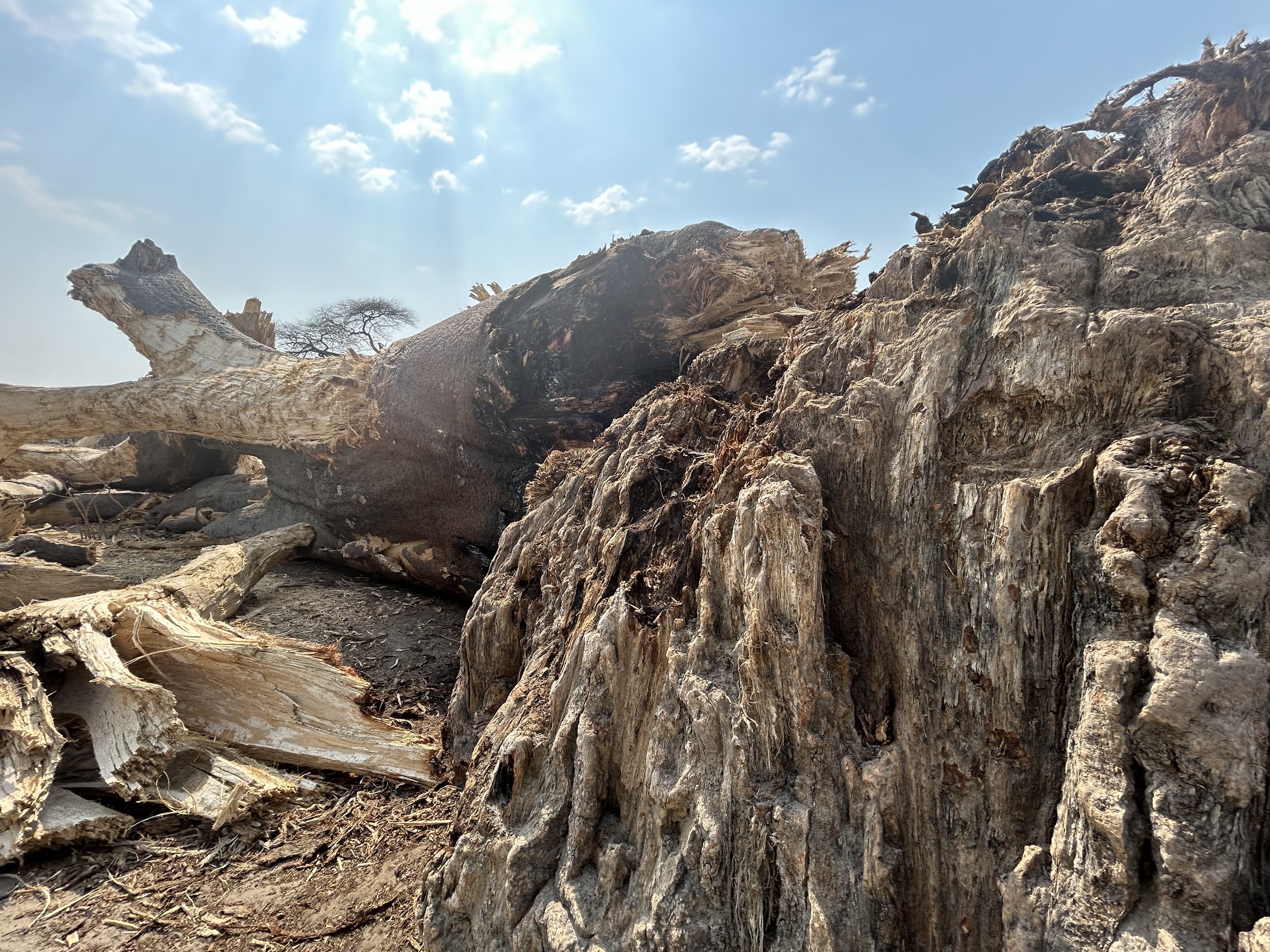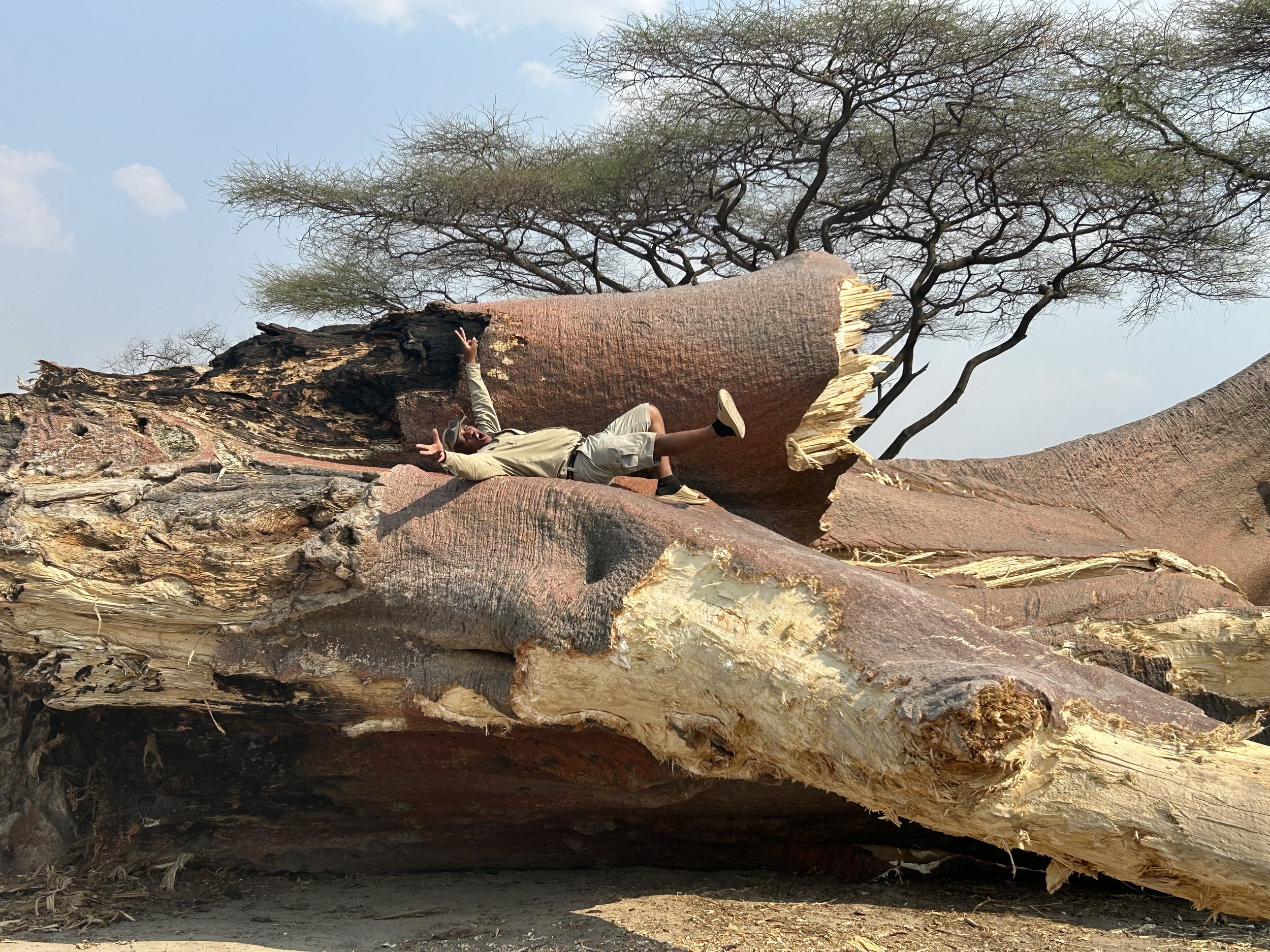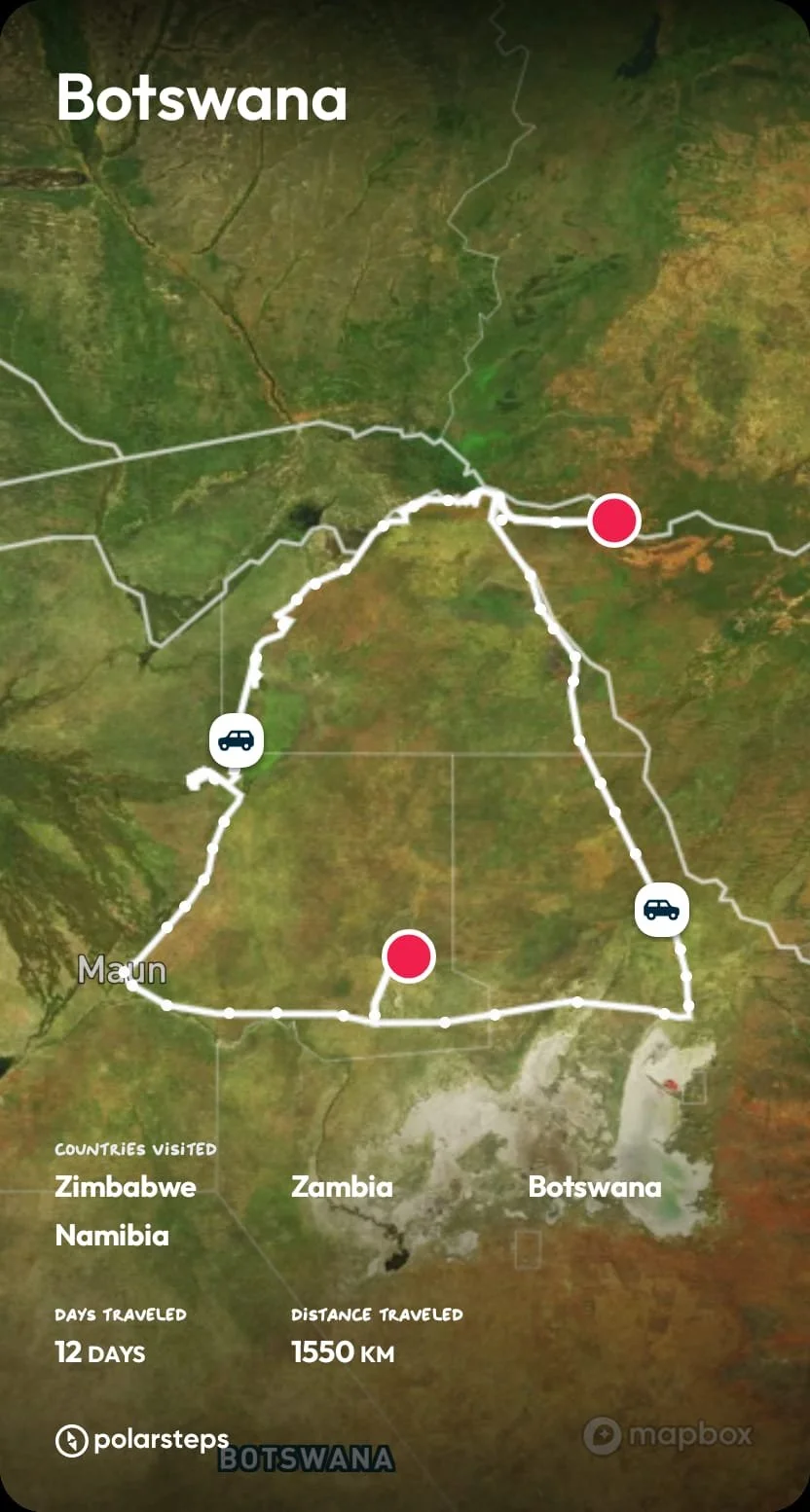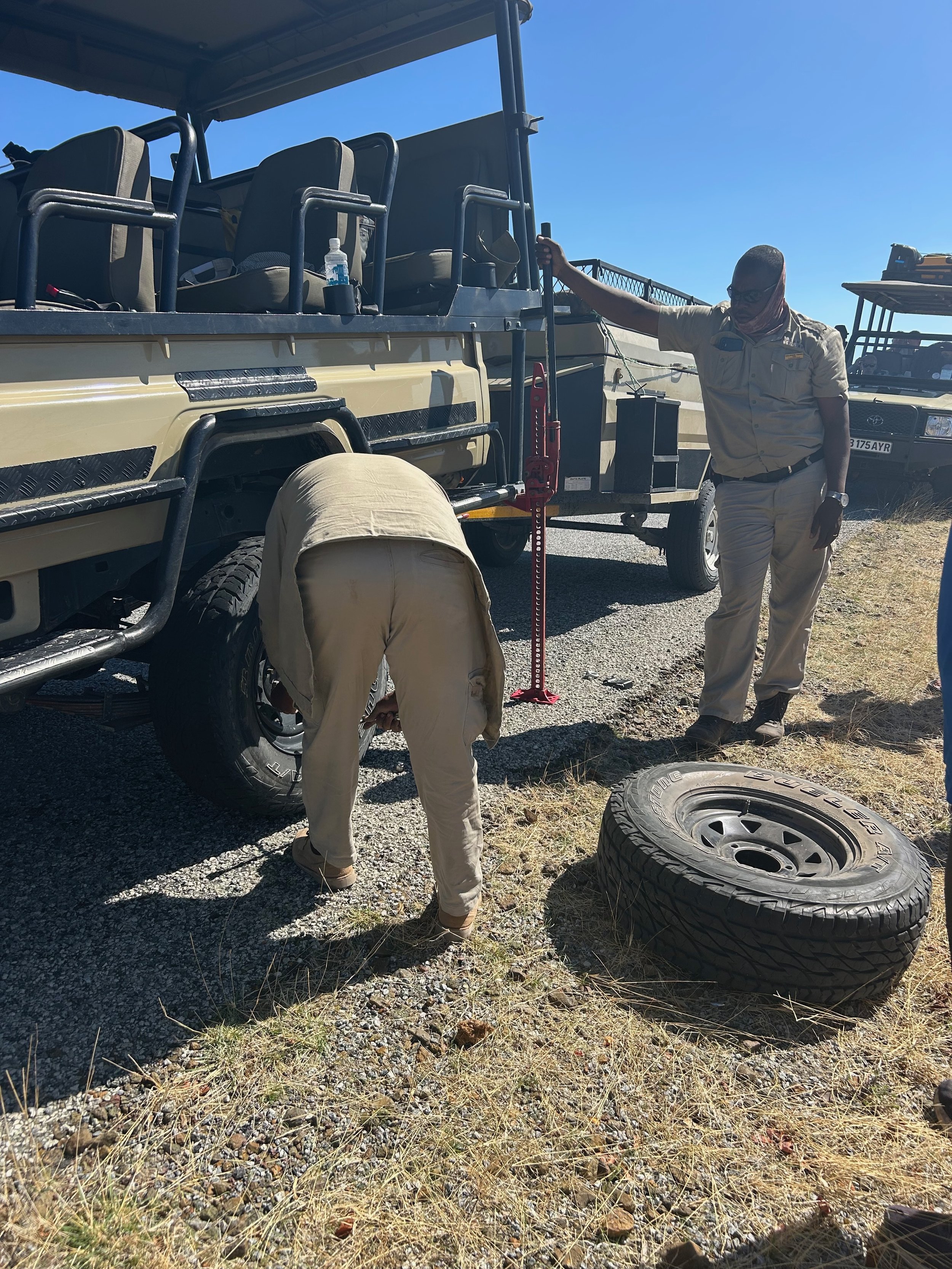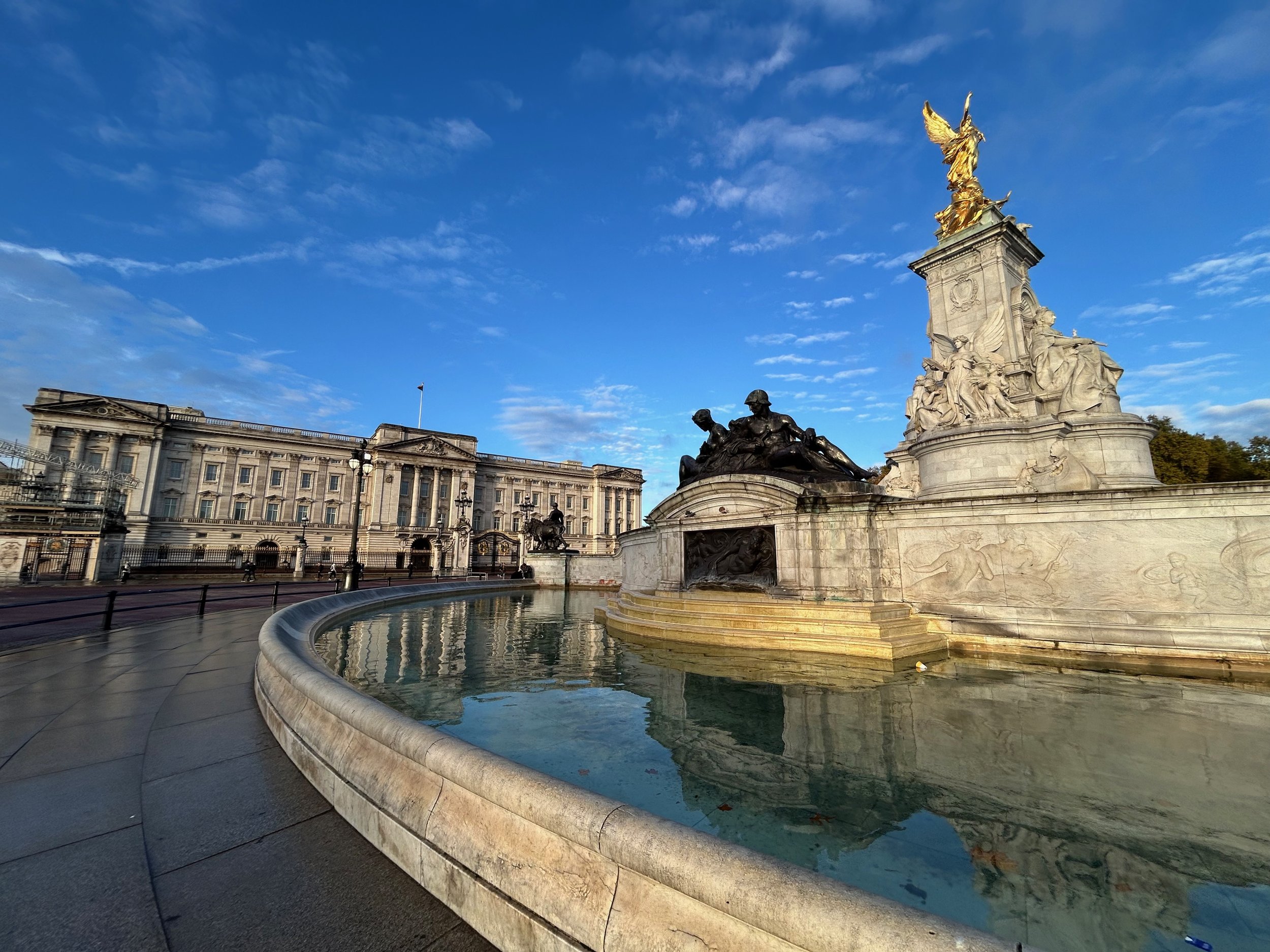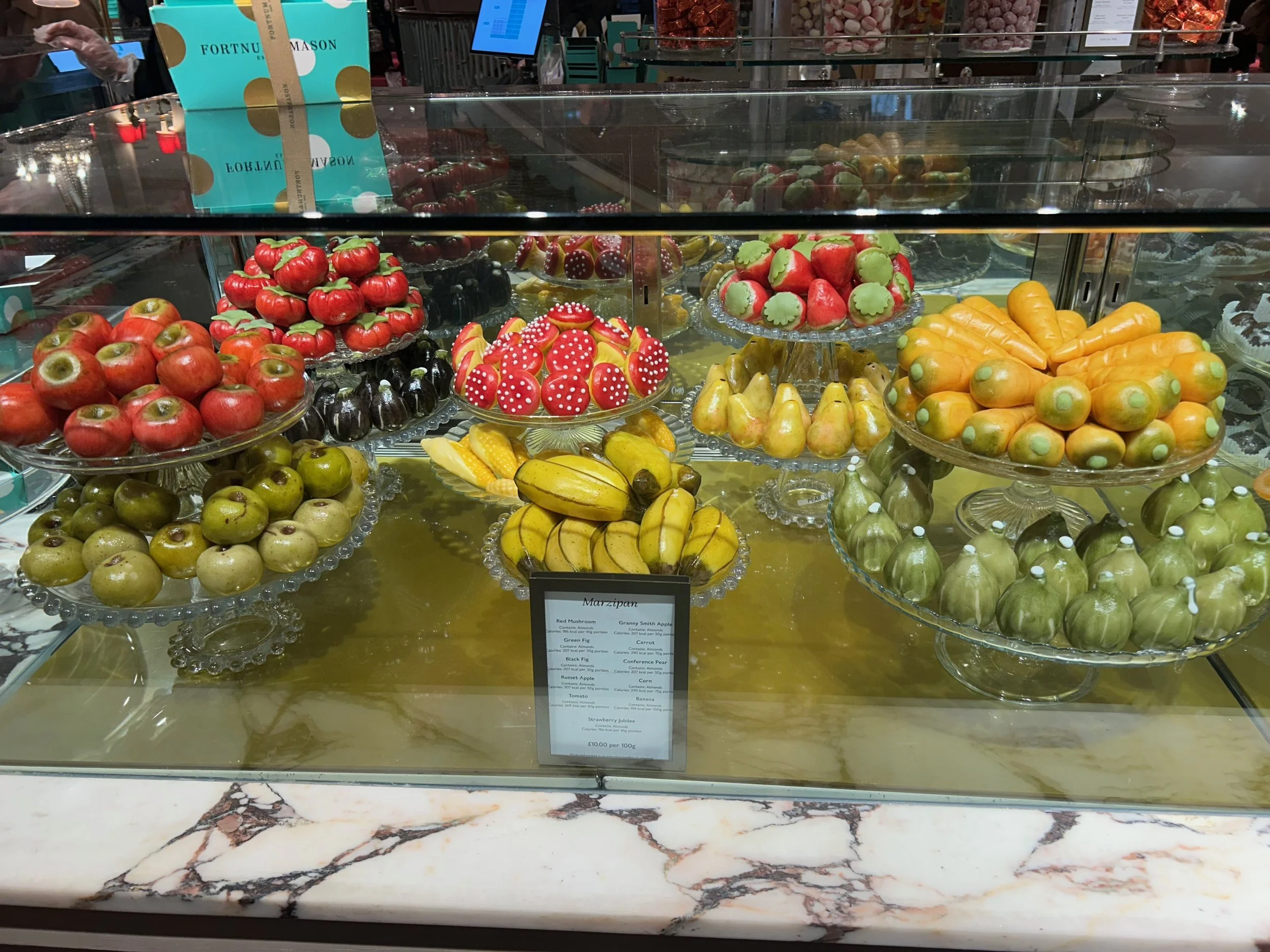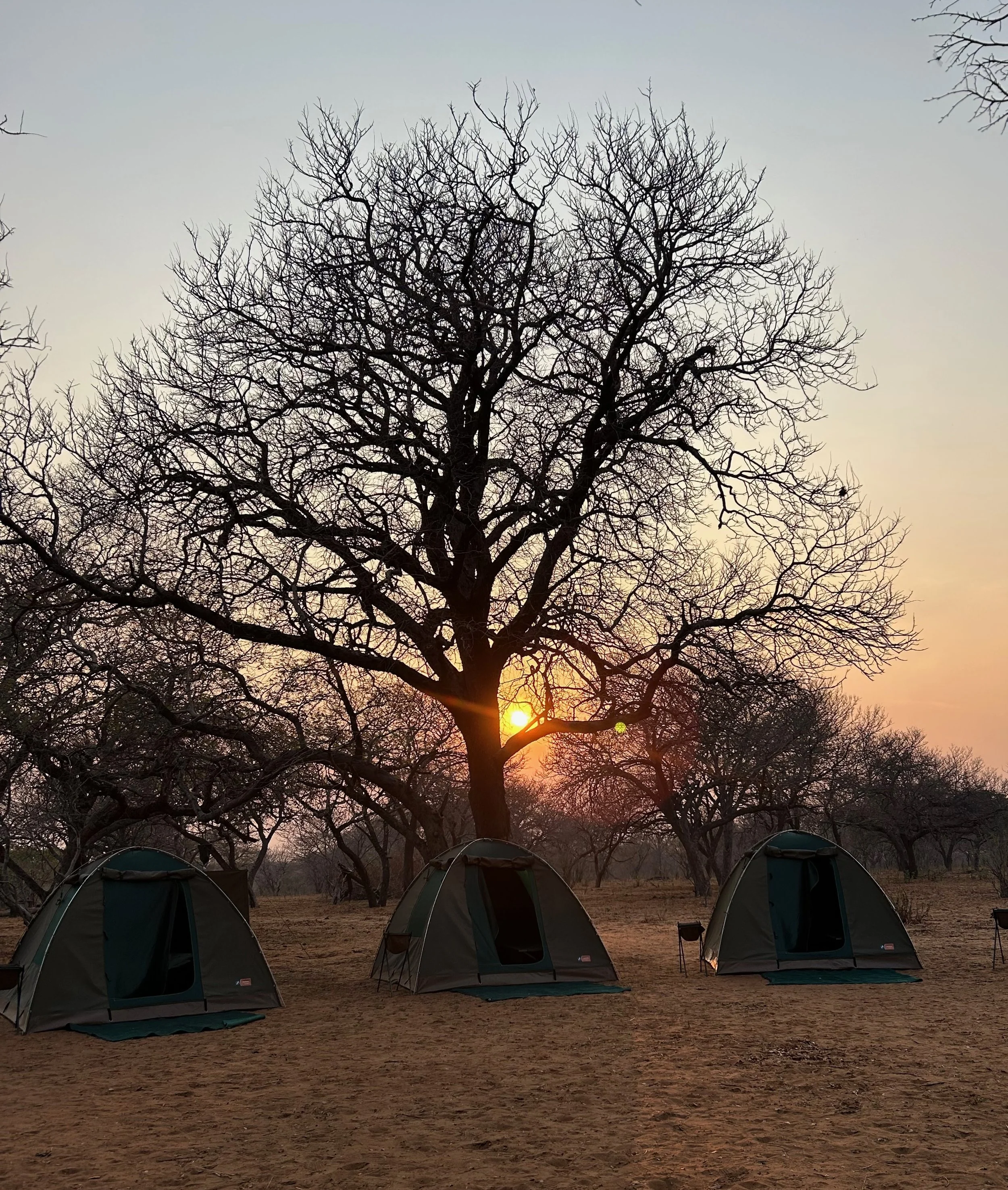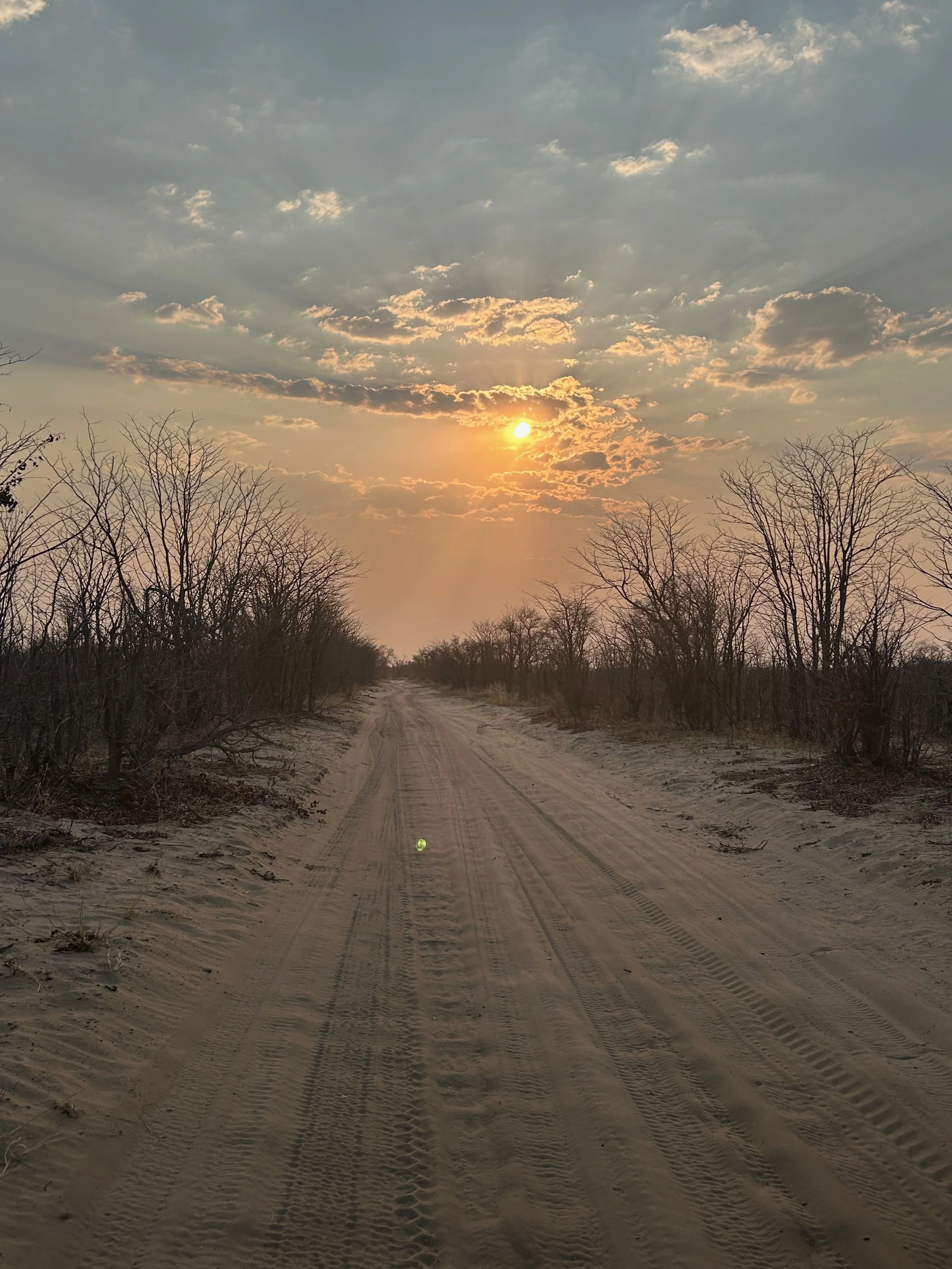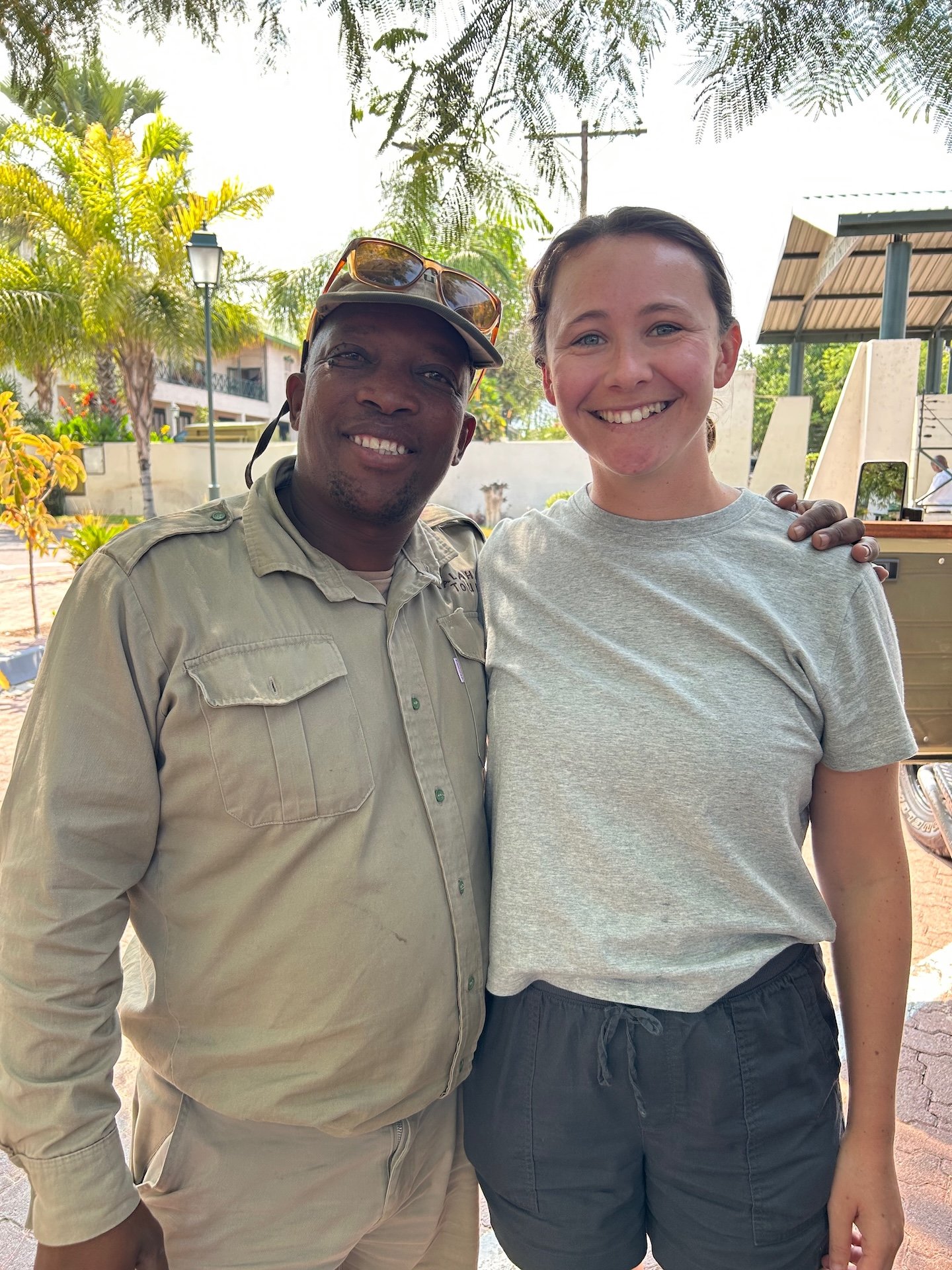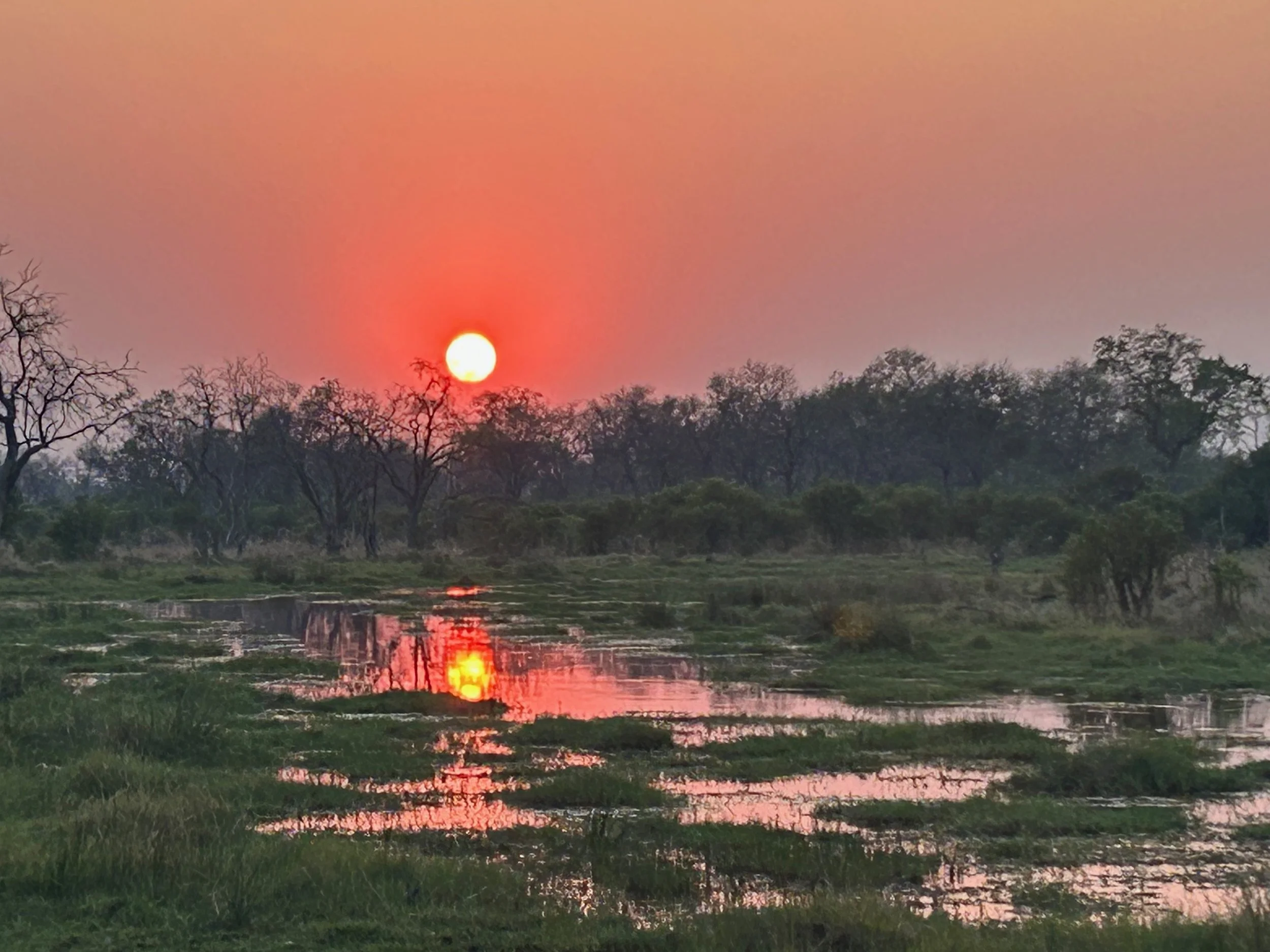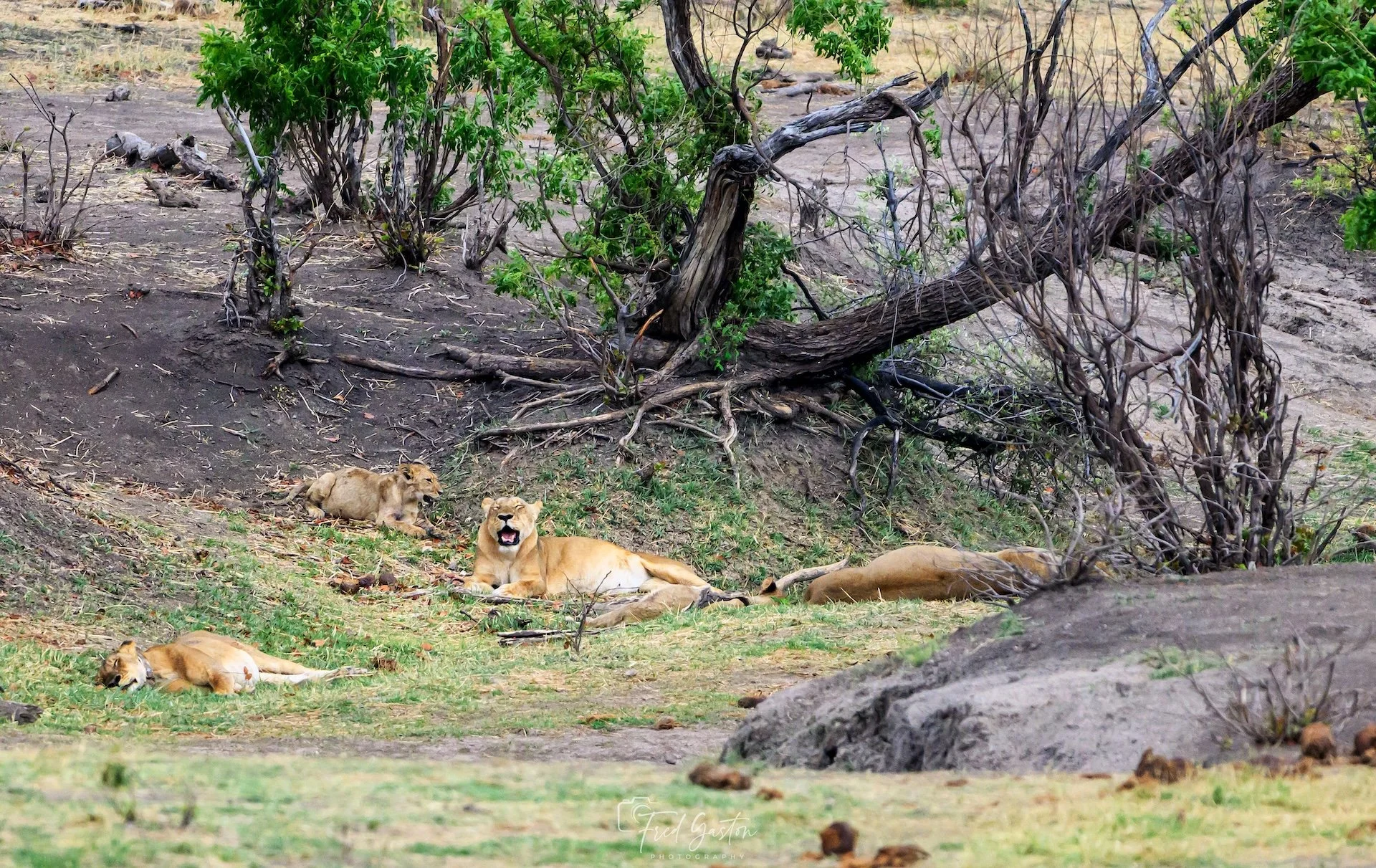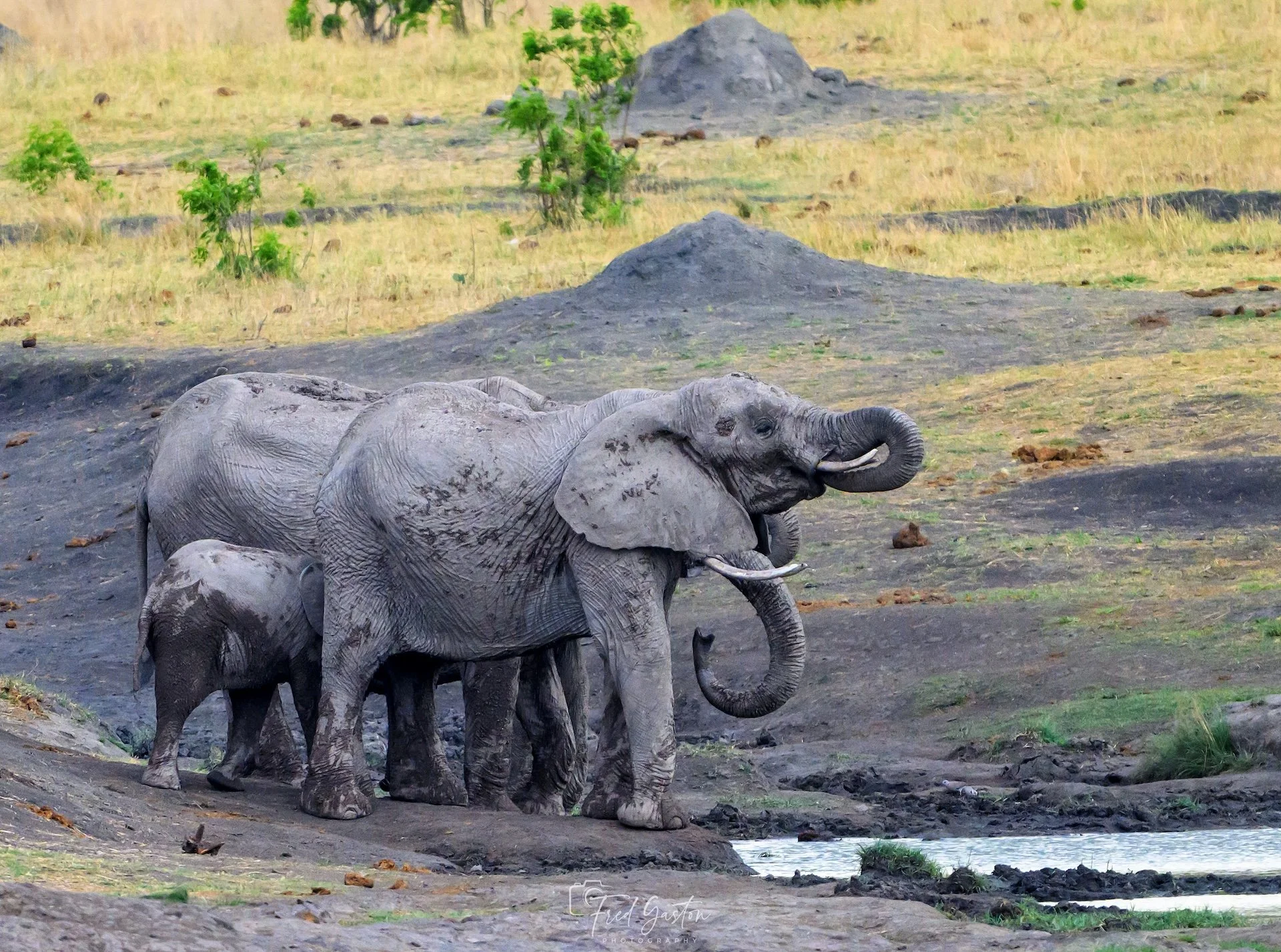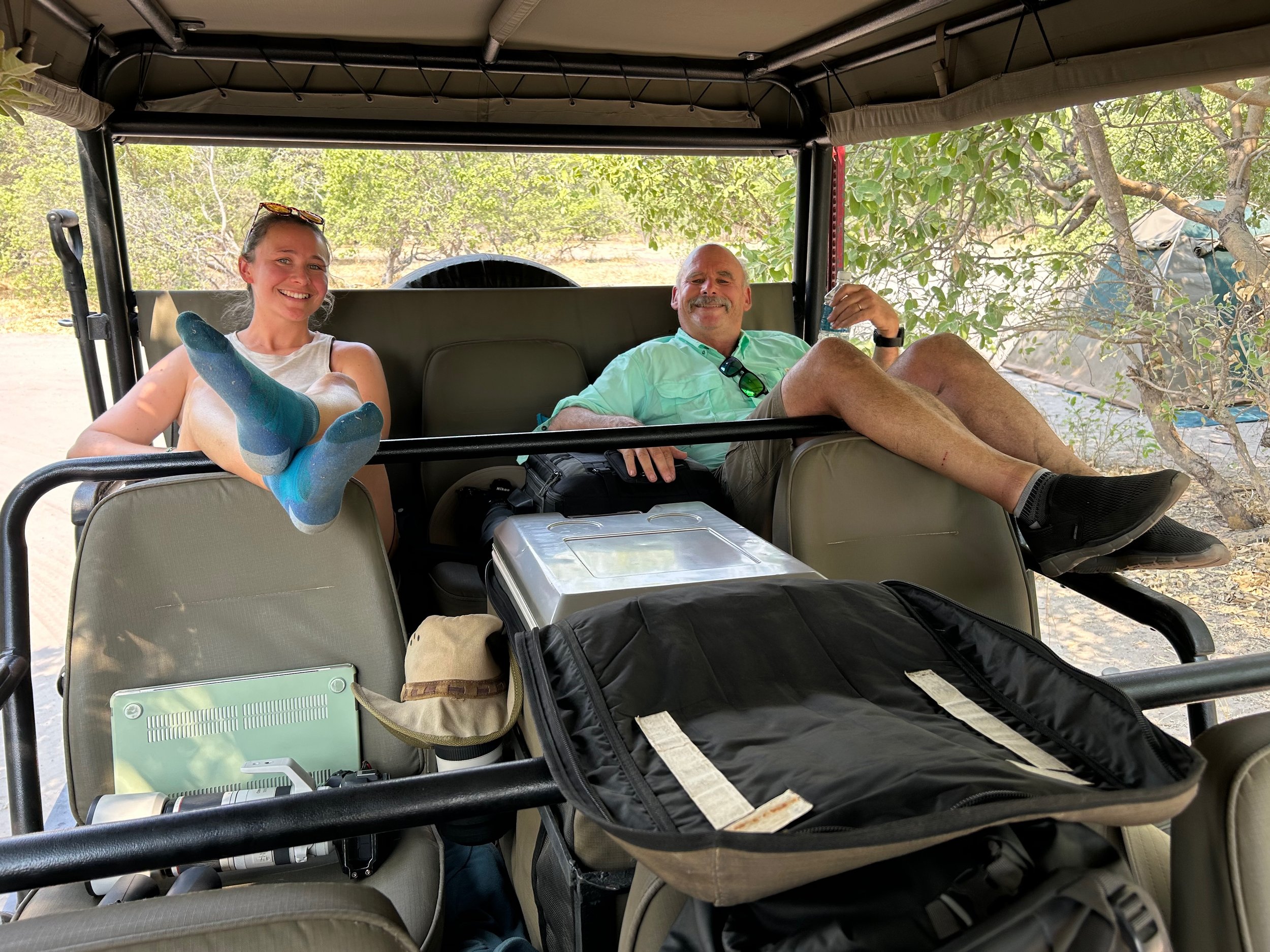
Botswana:
Across dust and distance
Travel Forethoughts…
In the months leading up to the trip, my thoughts kept drifting toward the continent I had yet to reach. Preparation was less about logistics and more about readiness of mind — a quiet sorting of curiosity, expectation, and fear of the sheer distance to travel.. I found myself imagining the landscapes I would encounter, the lives I might glimpse, the patterns and rhythms of a world I had not yet seen. Anticipation is both humbling and exhilarating. It asks you to hold uncertainty in your hands, to step toward a place that cannot be fully imagined, and to trust that every moment of observation will reveal something unexpected and extraordinary.
When the plane lifted into the morning sky from Boston, that anticipation intensified. Miles stretched between departure and arrival, each one a thread connecting what I was leaving behind with what I had yet to encounter. Suspended above the Atlantic, I felt the quiet thrill of possibility — a recognition that discovery begins not at the destination, but in the willingness to move forward, to open oneself up to what lies beyond the ordinary and familiar, and truly go beyond your comfort zone.
Reflections at 40,000 Feet
The flights to Botswana were long (24 hours)— the kind of journey that leaves you suspended between past and present. High above, with the cabin dark and the engines murmuring steady and low, my thoughts drifted back to another trip I’d taken and how I’d experienced similar emotions about what was to come. In 2017, my daughter and I joined my boss and his family to do community service in Nicaragua, building a home in a week for a needy family. Memories surfaced like scattered snapshots: unfamiliar lands, ungodly heat, camaraderie and the rhythm of mixing cement and laying block, and the people who walked those paths beside me.
It wasn’t just the hard work that left the deepest mark — it was the people and experiences in a very foreign land. The ones I served with who laughed in the face of exhaustion, who carried their fears quietly, who stepped forward when others hesitated. And of course the villagers and children we were there to serve offered another dimension of experience. Their lives unfolded in landscapes shaped by dust, scarcity, and endurance, and each encounter left marks I didn’t recognize at the time. Their resilience, their quiet strength, their grief and their laughter — all of it settled into me. And lastly, being in Central America, in a country with a violent past, in a poor remote village whose richness was measured in smiles and the warmth of its people, not material possessions.
Would Africa open my senses to create an amazing experience in the same way Nicaragua did? Would there also be a close relationship between hardship, an unfamiliar place and memorable experiences? My strong sense was yes, but with any trip to a foreign land I just didn’t know what I didn’t know.
Arrival In Victoria Falls, Zimbabwe
We arrived on October 14th, the air dry and hot, like 100 degrees hot. We would spend a day here before embarking on our 12 day safari to neighboring Botswana. Upon arriving at our lodge, I met up with the group I’d be traveling with — eleven others, all photographers, each chasing their own version of beauty. Together we would be setting off to explore Botswana, ready for whatever the land decided to show us. After a night of rest in Vic Falls, we rose for breakfast and then got back in a bus for a trip to the actual Falls, one of the 7 Wonders of the World.
Sunset Boat Safari
Later that day we took a sunset boat safari on the Zambeze River, which splits Zimbabwe and Zambia.. This was one of the highlights of the trip and our first taste of seeing animals we’d dreamed of seeing. Refreshed with local beers, and the ever present Gin & Tonic’s (this was a British colony mind you), we saw countless birds, and our first elephants, who’d come to the river bank to drink and take mud baths for sun protection.
The star of the show was the setting African sun, a sight that would spellbind us every night. Everything turned orange. And red. Even the grass wasn’t green anymore.
The Safari Trucks
Early the next morning, we boarded the bus again for an hour trip to the Botswana border, where we would meet our guides and switch to the open Toyota safari trucks that we would spend 6-8 hours a day in for the next 12 days. We walked the border crossing, washed the bottom of all our shoes and boarded the trucks for our drive to camp. First stop though: shop for snacks and beer, as we would be very remote for 4 days.
These safari trucks are purpose built for safaris, with 4 rows of seats that step up to afford everyone a view. Between the passengers in row 3 was a refrigerator that would be our life source in terms of keeping water bottles and beer chilled. With the dry heat we were each consuming about 3 liters of water a day to try to stay hydrated, but it was a never ending battle.
I would quickly find that riding in the rearmost seats carried its own form of entertainment. We were behind the rear axle and significant bump launched us and our camera gear off the seat. This would become known as the African “massage”.
Chobe’s Wildlife: Guardians of the Land
Shortly after a quick breakfast of yogurt and granola, we set out in our safari vehicles for one of our twice daily game drives in Chobe. Chobe is vast, 4,500 square miles, yet it is just a small blip in Botswana, a country that is virtually one large park. The air in the mornings was pleasantly cool, but we knew the heat would rise in shimmering waves from the plains as the day wore on. Morning game drives were our favorite, as they made us forget the unpleasantries of camping and no showers, and seemed to revitalize us in anticipation of seeing the animals. The land felt different here, wilder, as if it had been waiting for us — patient, watchful, and alive.
Savuti teemed with wildlife in every direction: springbok, impalas,, giraffes and elephants were everywhere, their movements rippling across the open plains like shifting patterns of light and dust. Yet we were always scanning for the uncommon — lions, leopards, cheetahs, wild dogs — the elusive heartbeats of the wild. Sometimes we’d be rewarded with unusual scenes like 2 sable mock fighting. Common among males, and often 2 brothers, this can go on for hours.
By mid-mornings, the landscape stretched endlessly, heat shimmering across the grass, dust rising in lazy spirals. Gravel crunched under tires. Shadows shifted. Every rise and hollow of the plains seemed alive with possibility. As we explored, a shape emerged far ahead — deliberate and unchallenged, moving with a quiet authority across the sun-warmed grass.
Broad shoulders rolled with quiet authority, muscles coiling and flexing beneath tawny fur with a fluid, primal grace. Each deliberate step pressed into the grass, a pulse of the wild itself, measured yet commanding. Dust danced in succession around its paws, shimmering in the heat haze like fleeting echoes of its power. Its gaze was deep, unblinking, carrying the weight of generations — a sovereign presence that seemed to weigh not just the land, but us, its guests in this vast domain.
It paused briefly, nostrils flaring, head tilting in subtle acknowledgment. There was intelligence in that stillness, a recognition of our presence without threat or hesitation. The lion was more than a hunter; it was the embodiment of the raw, elemental power of nature — patient, deliberate, and unyielding. Its calm inevitability spoke of authority older than memory, a force that shaped the plains, the light, the shadows, and every movement within them. Even the wind seemed to shift around it, bending to its rhythm, acknowledging a power beyond human reckoning. In that suspended moment, awe was not simply an emotion — it was the recognition of life untamed, sovereign, and eternal, a pulse of the wild made tangible.
The day rolled on. Heat hung above the sunbaked grass. Dust rose and settled, drifting in golden spirals. The gravel and dirt track wound forward, tires crunching, wind stirring dust and carrying the dry scent of earth. Herds of springbok grazed in rhythmic motion, heads dipping and rising like metronomes, their ears twitching at each sound. Lone jackals at bat eared foxes traced deliberate paths through the grass, alert yet unbothered by our presence. Dust rose with every small movement of the vehicle, caught in rays of sunlight that bent and shimmered in the heat haze. Each ripple of light and shadow across the plains revealed textures unseen before, highlighting every tuft of grass, every uneven rise in the earth, every small animal weaving its quiet life into the vastness.
Conversations had dwindled to murmurs. Every camera rested lightly in laps, fingers poised on triggers, yet no one wanted to break the spell. There was a sense of waiting — a rhythm to the land itself, a pulse that demanded patience. Even the air felt suspended, humming softly with the energy of hidden life, carrying the scent of warm dust, dry grass, and something ancient and alive that lingered just beyond the visible.
We followed the winding dirt track across gentle rises, gravel and sand crunching beneath the tires, the vehicle swaying slightly as we adjusted to the contours of the terrain. Shadows lengthened, light softened, and the plains slowly shifted from gold to warmer, honeyed tones. The subtle movements of distant animals — a grazing herd, the flick of a tail, a lone bird taking flight — reminded us that the wild was always present, even when unseen.
Eyes remained vigilant, scanning every horizon. The light played tricks, heat haze bending shapes into forms that might or might not be there. Anticipation built silently, organically, not from urgency but from the quiet knowledge that the land had its own schedule, revealing its wonders on its own terms.
We continued across the sunlit grasslands, the landscape stretching endlessly in every direction, dust rising with every turn of the tires. Shadows shifted gently over the low shrubs and isolated trees, and the rhythm of the plains seemed to pulse beneath us.
Then, from the haze of heat and light, shapes began to emerge, moving with a presence that seemed inseparable from the land itself. Elephants! Broad shoulders rolled with weight and purpose, muscles flexing beneath sunlit skin, dust lifting in soft spirals at their feet. They moved slowly, yet with a kind of authority that needed no haste — each step deliberate, resonant, a physical echo of the plains. Watching them, it became impossible not to sense the age and scale of the earth itself in motion, to feel the land’s endurance embodied in flesh and bone.
Their passage across the open grasslands was mesmerizing. They moved among scattered shrubs and isolated trees, tracing paths that felt ancient, written by generations long past. In the sway of their heads, the shift of each shoulder, and the slow power in their gait, one could see the memory of countless seasons etched into the land itself. Dust rose around them in columns, catching the light and blurring the edges of their forms, as if the sun and sand conspired to frame their presence in reverent homage.
In that moment, it was impossible to separate observer from observed. The elephants were more than creatures we watched — they were both narrative and narrator, mirrors of the land and its story. Their movement carried the pulse of Etosha, the quiet authority of the wild, the patient rhythm of life that persists through heat, drought, and time. Every step seemed to say that existence is a balance of resilience and grace, of strength tempered by awareness, of history carried forward in quiet, enduring ways.
As we followed the herd across the plains, the sense of scale was humbling. The elephants were enormous, yet they moved with a care that made them part of the land rather than imposing upon it. Each shadow, each rustle of grass, each swirl of dust was a reminder that the plains themselves were alive, responding to their passage, echoing their rhythm. They were guardians of memory, embodiments of the wild’s patient, sovereign power, carrying the story of Etosha across every ridge, every hollow, every horizon.
And in that presence, we too felt a part of the landscape, small yet attentive, witnesses to a rhythm older than any human measure. The elephants were living monuments, cinematic in their scale and movement, yet intimate in the way their steps communicated endurance, memory, and the quiet, enduring pulse of the land. They were a reminder that the wild has its own authority, its own history, and its own way of revealing the depth and beauty of the world to those who pause long enough to see.
Having seen one leopard earlier in our trip, our expectations were not high that we would see more, but our luck continued in Savuti. Late afternoon, our guide found this magnificent jaguar resting under a tree. Not far away, among the trees, impalas grazed and it became evident this jaguar was beginning a hunt. Expecting an immediate chase and kill, we were told by our guide these hunts can last 3 hours, becoming a slow chess match that usually ends at night when it favors the hunter. Seeming to lose connection with the impalas, the jaguar knew where they were and would slink to another location to rest and observe. As the light began to fade, the leopard went up a hill into high grass to begin making a long arc, while remaining very camouflaged to intercept the impalas. It was too dark to remain and see the outcome, but the patience and beauty of this animal will remain with me forever.
The sun dipped lower, molten gold fading to deep amber, as we headed back to camp. The elephants had moved on, leaving dust and memory in its wake. The lion of the morning and the jaguar of the afternoon — two encounters, worlds apart, yet bound by the same thread of reverence. The plains seemed alive with vast openness, each ripple of grass, each spiral of dust, each flicker of sunlight carrying echoes of their presence.
It’s hard not to feel the weight of it all — the vastness of the land, the endurance of the creatures, the fragility and brilliance of our own existence within it. Photographs captured light and shape, but not pulse, not dust spinning in arcs, not sway of ears in sunlight, not the tremor of earth beneath giant feet. That, I carried in my chest through pure raw emotion.
As the last light faded around a watering hole, painting the plains in deep amber and shadow, I realized that moments like these were not meant to be fully grasped. They were meant to be felt, to linger, to remind us that life moves with its own rhythm, monumental, patient, and unhurried. And in that awareness, I felt profoundly alive, senses stretched, mind open, heart tethered to the wild in a way I would never forget.
The Camping Experience
I’d be lying if I didn’t admit the months before this trip weren’t filled with dread about the camping component of this trip. Filled with long ago memories of struggling with putting up tents, smoky clothes and sleepless nights on hard earth, the thought of nights camping weighed heavily on my mind as the long miles rolled by that day.
By late-afternoon after a very long drive, the camp came into view, its simple canvas tents standing like quiet sentinels among the trees. There would be no luxury and our world shrank to essentials: the rustle of canvas in the wind, the faint cool of evening, and the profound quiet that only a place removed from civilization can offer. Exhaustion pressed heavily, but I was aware that feeling when the body and mind are in sync with the rhythm of the land itself, stripped down to the essentials.
Knowing that the advanced team arrived the day before to setup camp, it was comforting to see our dinner table and chairs setup with bottles of wine and illuminated by solar lamps on trees. Maybe this would ok after all! We were assigned to our tents and given careful explanation about the “toilets”, which were vertical tents erected over a hole in the ground with a toilet seat. “Remember, the animals will be wandering through our camp at night, so you must be accompanied by your tent-mate if you wish to use the toilet during the night. And the toilet paper placed on top of the enclosure is your sign that it is unoccupied”. We all quickly decided that with the threat of huge predators roaming our campground, we were going to do everything to avoid needing to use the toilet before dawn, but that was a pipe-dream. Emerging from the tent sometime in the night for a pee, the camp lay in complete black stillness, wrapped in a soft hush broken only by the faint rustle of leaves and the whisper of the desert wind. The sand crunched softly beneath my shoes, each step amplifying the silence. I decided to go just behind the tent.
Above me, the night sky stretched in infinite darkness, stars blazing in countless constellations, each one a distant witness to the world below. The brilliance of the heavens mirrored the quiet intensity of the camp, as if the universe itself had spotlighted this small, fleeting moment. I felt the weight of it all — the wildness, the stillness, and the vast, unmeasurable sky — converging into something intangible, impossible to fully grasp yet impossible to forget. In that silence, framed by darkness, fear of what was out there, and the sweep of the stars, I understood that some moments exist only to be felt, lingering between heartbeat and breath, a delicate reminder of how small we are, and yet how profoundly alive we can feel.
Special thanks to the advanced team, who also doubled as our cooks. Meals were always made from fresh ingredients and we marveled at how they could keep fruit, meat and milk cold for the 3 1/2 days we’d spend there. We settled into what would become routine for the next 12 days-ladies first except for one Russian who seemed not to understand the rules, but lived in the US and just chose to ignore them (much aggravation for everyone during the trip).
As mentioned, we were warned animals would come into the camp at night and scavenge for any food that should have been stored. Which animals they were referring was left to our imaginations, and Maurice Sendak’s illustrations came flooding back many years after reading his books to my kids. I woke the first night dreading the sound I clearly heard: snorts, tearing and loud noises. I quickly remembered I’d left my bag of snacks by the fire pit and prepared to be scalded by our guides for my carelessness for what seemed like hours, but of course I was not brave enough to go confirm this was the source of the noise. Upon stumbling out of the tent when morning finally came (5:30 ish) , I began apologizing that I had violated the rules and I bear responsibility for everyone having a sleepless night when I discovered to my delight that my plastic bag of snacks was miraculously untouched. I’ll never know what animal got into something, but was relieved I wasn’t the cause!
More Camping at Nxai Pan National Park
We continued our journey to a chill overnight at a hotel in Maun, a largely administrative city that broke up our long drive to Nxai Park. As you can see on the map Maun was at the end of just one leg of the triangle of our 1,000 mile drive in Botswana. We had many more miles to cover to get to Nxai, famous for its pan which is a salt flat.
In Maun, I had the best massage of my life. The 90 minute session counteracted the hours of “African massage” I received bouncing over endless bumps in the back of. the safari truck the last week. The road from Maun to Nxai Pan was largely highway but offered no respite from the hot African sun. Our truck suffered a flat on the long drive which would have been impossible to fix with traditional tools, as the truck is heavy and tires massive. Fortunately the trucks are equipped with appropriate equipment and we were soon on the road again, after baking on the side of the road in the midday sun.
The premise of visiting Botswana in the dry season is that waterholes serve as the only source of sustenance to all animals, and this was on full display at our destination. The depleted waterhole gave life to a great variety of animals but life’s counterpart, death, was also on full display, bringing to mind the ever-present Circle of Life in Africa.
Two relatively recent kills, an elephant and wildebeest, teemed with scavengers. Jackals were the dominant scavenger, always surrounded by buzzards looking for their fill. While we were initially sickened by the sight and smell, we came to accept that life and death are a constant companion here. We saw countless elephant skulls and bones everywhere we went. Our guides explained they likely died of old age after their last set of teeth were worn down to being unusable, but lions do occasionally bring down an adult elephant by working as a team. One evening at sunset a herd of elephants appeared on the horizon and came to drink from the life giving waterhole, seemingly oblivious to their fallen brother just yards away. While we heard that elephants will often honor and grieve their dead, we didn’t see that on display here.
The animal kingdom in Botswana seems to be divided between predators and scavengers, and prey. Some animals like jackals and hyenas are both though, which was on display in Nxai Park. On our last game drive there, we came across a horrid sight: a jackal had just brought down a springbok or impala and was eating it alive, tearing its intestines out while it cried. This was too much for me to watch but it is just part of life there and you have to put aside your sensibilities about animal suffering and accept this is nature, and everything has to eat or they will die. Even hawks used the waterhole to kill and eat other birds.
Other highlights in Nxai included multiple ostrich sightings and families of bat eared foxes, adorable creatures that were very skittish and ran as we approached. Our last morning in Nxai Pan we had an incredible lion sighting that again required us to break the rules and go off-road. Probably tipped off by other guides, Opi sped towards stands of trees searching for the pride. Once he found it, we discovered families under multiple trees, all trying to escape the oppressive midday heat. As we’d seen before, the lions were all lying on top of each other in various hilarious positions. After many photographs, we gave up our spot for our other vehicle, but Opi wasn’t done delivering the goods. His magnum opus that day was finding a mating pair of lions nearby. They eventually got up and we were treated them walking together, their passion for each other on display. They eventually plopped down under another tree and we got excellent close-ups of their faces.
Nothing makes you feel more alive than a lion walking straight toward you in an open safari vehicle. You might wonder why don't attack in these situations. It’s widely believed they see the vehicle and its occupants as just a vehicle, rather than noticing people inside. That’s why it’s important to keep movement and noise to a minimum at a sighting so you can witness them as undisturbed as possible, behaving as if you weren’t there at all.
There were an abundance of giraffes and ostriches at Nxai. Seeing an ostrich run or a giraffe bend its legs to drink at a waterhole were special.
Our final night we were treated to a world class sunset at the waterhole. As the sun went down behind the elephant carcass we continued to photograph, with the ever present scavengers tugging away, the visible sky turning a bright pink with clouds contrasted in blue. Perched atop a tree with a perfect canopy, scores of vultures stood motionless, forming a perfect composition. As the last light faded, painting the plains in deep amber and shadow, I realized that moments like these were not meant to be fully grasped. They were meant to be felt, to linger, to remind us that life moves with its own rhythm, monumental, patient, and unhurried. And in that awareness, I felt profoundly alive, senses stretched, mind open, heart tethered to the wild in a way I would never forget.
Our Botswana trip was coming to an end. Tomorrow we’d have one more night of glamping then drive back to the border and spend our final night with the group back in Vic Falls. Although the 12 days seemed so long because of the camping, the togetherness with our companions and the 1,000 miles of tough roads, we all knew we’d been changed by our experience here and would quickly miss our guides and the animals in this place.
Elephant Sands
We would spend our final night in Botswana, again after a very long drive, at Elephant Sands Lodge, a glamping lodge in the north-east. Built around a natural waterhole right in front of the lodge, and with no fences, the elephants rule here. As we waited to be assigned to our individual lodges, several of us ventured too close to the waterhole and were admonished by another guide: “don't you know these animals are wild and this isn’t a zoo!”. But as was we later converged on the bar patio, not 10 feet from the herd, and we thought about what he had said, we couldn’t figure out why the elephants weren’t agitated by us. Similar to our safari trucks, the elephants were conditioned to humans sitting there, as long as they remained behind the small wall of the patio.
The commotion caused by different families competing for the waterhole spring was both awe inspiring and terrifying. A family’s massive matriarch would nudge members of other families out of the way with her tusks and combination of deep rumbles, loud growls, roars and trumpeting sounds.. Watching 4 ton animals jostle for position so close required several drinks to stay calm!
The Trip Home
After returning from our final game drive and a quick breakfast, we reboarded our truck for the drive back to Vic Falls airport. Knowing we had 30 hours of travel somehow dulled the last 2 hour African “massage” in the truck. We had lunch with Thomas, our German travel companion, at the airport while the electricity went on and off (this is Africa after all), and then it was finally time to board the first flight of our journey to Johannesburg. We had a long layover in London (6 hours), so decided to meetup with Ed, another travel companion, who was already home in London, and graciously offered to meet us at Paddington Station at 6AM and give us a walking tour of London.
Although exhausted from 2 weeks of safari, and 2 flights from Africa, we were exhilarated to be in London. We exited the station to an iconic rainy, cold London morning, but after a quick stop for croissants and tea, the weather turned sunny for our tour. Ed, the consummate host, hit all the top tourist spots and filled us in on must know info like which Royal lives or works here, the rent for flats in different areas, etc. We capped off our layover with a stop at Fortnum & Mason, a historic high-end department store famous for its luxury foods and tea, which has served the Royal family for centuries.
When we boarded the Heathrow Express at Paddington, the station was being evacuated but our train managed to leave, but that would be the first sign of travel troubles to come. We arrived at Terminal 5, where the majority of international flights depart, ready to check-in where we were promptly told our flight was actually in Terminal 3 but not to worry as it’s just a quick 5 minute shuttle. Unfortunately, the whole Heathrow Express system was shut down, and everyone had to divert to the subway, which took considerably longer. The upshot was we were late and Sophie missed the check-in time and was barred from our flight. In a split second decision, she told me to go; no sense having us both try to reschedule. Seeing that my flight was already boarding, I ran-walked about 20 minutes to make my flight. Stressful, especially because Sophie was stranded, I settled into my seat to learn she had been rebooked on a flight 2 hours later, but they’d charged her $1,500 and stuck her in the very back of the plane. Oh well, we both made it home although she had another flight early the next morning to Denver.
Our Guides & Close Encounters
Where do I start. We were told by our expert guides we really got lucky in what we saw. We had repeated sightings of wild dogs, an animal few see as it’s one of Botswana’s most endangered. As elusive as leopards are, we saw them repeatedly and not just resting under trees during the mid-day heat, but during their hunts. And so many prides of lions, I can’t remember how many. Our guide Opi had an instinct for finding these animals, which often required going off road, a no-no in these parks, but it seemed to be the norm as long as nobody reported us.
We joked that Opi, pictured to the left with Sophie, was the mayor of Botswana. He stopped to talk to the driver of every safari truck we passed, which was countless after 12 days. It seemed like he knew everyone. During these stops he would probe the other driver about what and where they’d seen animals. Or he’d be on his radio chatting in his native Satswana asking for animal reports, or sharing his finds. Then we’d be driving and he’d randomly pull off the road and race to some distant stand of trees in the distance. There, under the trees and invisible from the road, would be a pride of adult female lions napping with their cubs. Despite our truck being no more than 15 feet away, they showed absolutely no interest in us, maybe just lazily raising their head to confirm it was just another safari truck of photographers. Sprawled in different positions, some would be on their backs with a leg in the air resting against a branch. Or giving the cubs a bath.
From 19 years of animal tracking, Opi knew there would be a male or breeding pair nearby. How he always knew where remained a mystery, but we’d make a big arcing turn and within several hundred yards we’d pull up to the solitary king of the jungle. If it was a mating pair, Opi would warn us they’re very aggressive and to not speak or put our arms or legs out of the vehicle. It never failed to amaze me we were so close to these apex predators, capable of bringing down a 2000 pound buffalo, and as long as we followed the rules, they wouldn’t attack us.
One of the more awesome (and frightening) encounters was coming upon a large pride that was eating something.. There were lions everywhere under all the surrounding trees. On closer inspection, the family consisted of two adult male brothers, at least 6 adult females and countless cubs. There was a definite hierarchy and pecking order in terms of eating. Sad as it was, they had separated a baby elephant and killed it. The males had already had their fill and when we arrived the females and youngsters were competing for the carcass.
In what Opi would tell us was an extremely rare occurrence, the dominant male heard the adult females growling at the cubs for trying to eat and came over with intent from under a neighboring tree directly toward me, or so I thought. He passed so close to my corner of the vehicle my heart stopped. What happened next is indescribable, which is why I included the video. With all his power and strength on display, he chased the adult females away from the kill so that his cubs could get their turn. If you have never seen an adult male lion lunge and growl in person, it is an awesome spectacle. And this was presenting itself right in front of us. Not something you see in the zoo!
Leaving Chobe
After 3 nights in our Savuti camp in the heart of Chobe, it was time to move on. We awoke before the sun fully climbed to the sight of giraffes just outside our camp- a beautiful memory. We helped pack our tents and cots after breakfast before we headed out for our final game drive in Chobe before we drove towards the southwestern entrance of this vast park towards a glamping respite in the Okavango Delta. The long long game drives, early mornings and camping had caught up with us — exhaustion pressed against our bodies, our muscles aching from the constant motion of the vehicle. We looked forward to some comfort.
Yet despite the fatigue, there was a quiet force that kept us moving forward. Once we got in the trucks, every glimpse of wildlife reminded us why we were here and made us forget our temporary hardships. Conversation was minimal; energy conserved. Still, hearts and minds remained alert, fueled by the promise of discovery around the next bend. There was a tension in it — the body begging for rest while curiosity and wonder urged us onward — and it became its own rhythm, a delicate balance between endurance and exhilaration.
Still within the park but tucked among jagged hills and rocky outcrops, the land felt even more ancient, the air heavy with stillness and the subtle sounds of distant wildlife. That morning was painted in golds and violets as the sun spilled across ochre stone, casting long, fluid shadows. Small bursts of life punctuated the silence: insects scuttling, fresh jaguar tracks and birds calling sharply.
We stopped briefly at a rocky outcrop to see ancient rock paintings. The stop offered just enough time to absorb the stillness of the rocky outcrops, jagged ridges casting long shadows across ochre stone. The whispering hints of ancient human presence and subtle rock engravings marking where ancestors once stood where we were.
The animals are the star of our trip, but we mustn’t forget the supporting cast. Elephants have very inefficient digestive systems and must eat about 17-18 hours a day. They leave destruction in their wake, scores of bushes with broken branches. One extreme example of both their power and quest for food was a fallen baobab tree. These iconic giants are impossible to miss with their thick trunks and beautiful canopies. Known as the tree of life, it is actually a succulent and its stem becomes hollow, allowing it to store tens of thousands of gallons of water which it can use during the dry season, but is also used by animals.
Being so massive you would think that these trees are almost indestructible, but there is another giant in the bush that can cause great damage; the African elephant. In times of water shortage or elephant overpopulation, baobabs become very popular. Elephants instinctively know that baobabs store water and especially in the dry season when water is scarce they will look for baobab trees to quench their thirst. But elephants depend on water on a more regular basis, they need a water supply of more than 100 litres per animal per day. The elephants rip large pieces from the trunks of the trees or tear off entire branches to get to nutrients and stored water. And as the bark of the baobab is soft enough for an elephant to poke a hole in the bark it is easy to rip the bark off. Once the tree is stripped of its protective bark, the elephant can get to the best part – the inner part of the tree. This part is like a sponge – rather like a watermelon. Chewing on the flesh can quench an elephant’s thirst.
Elephants had actually pushed this massive baobab tree over, in a raw display of power, which seemed impossible given its size but once we learned and saw the truck was hollow it made more sense. Two giants in the African landscape with intertwined existences. Expecting the wood to be dry and hard, our guide showed us it was still soft and wet, despite having fallen weeks ago.
The plains of Chobe would leave their mark on us — the lion’s gaze still burned in memory, the elephant’s monumental presence lingering like a heartbeat in the desert heat. Even as we drove away from the park, the rhythm of the wild seemed to pulse beneath the tires, carried in every gust of wind, every shifting shadow across the grass. The dust of the gravel and dirt roads clung to the vehicle, glittering in the sunlight, a reminder that here, even the smallest movement stirred the land itself.
A Glamping Respite from Camping
After four days of roughing it and no shower, we made our way to one of Botswana’s most popular destinations, the Okavango Delta and the Kawhii Lodge. It is a vast inland delta in Botswana formed where the Okavango River reaches a tectonic trough at an elevation of about 3,000 ft in the central part of the basin of the Kalahari Desert. It is a UNESCO World Heritage Site, as one of the few interior delta systems that do not flow into a sea or ocean, with a wetland system that is largely intact.
The Kawhi Expedition Camp is a luxury lodge that has everything to please and scores very high on my all-time list. I is a wonderful and incredible place, one of those places that is absolutely worth visiting once in your life. First, the accommodations surrounded by nature are beautiful- eating and sleeping in the middle of the jungle and listening to the jungle itself is an incredible experience beyond words. From the second you arrive, the staff is hyper attentive, always taking care of every detail and with exquisite kindness and treatment. All meals are cooked by the chef, who explains to you beforehand what you are going to eat. Both the presentation and the flavor are carefully curated, and the food is very healthy, varied, and delicious.
We were greeted in the parking lot by the general manager with hot towels to wipe our dirty faces and escorted to the central area, where multiple dining spaces, an open bar and fire pit all faced the delta. Hippos and buffalo grazed in the water as the sun began to set. We were shown to our individual tent huts and were delighted to see each had proper beds, electricity and a partially outdoor bathroom with a luxurious shower and toilet, something we had sorely missed for 4 days.
We later gathered for a lovely dinner, hosted by the manager and carefully attended to by the head chef and her assistants. We spent two amazing nights based here, exploring the Delta and its rich diversity of animals and experiences by day.
One unique experience was riding in makoros in the delta for a sunset water safari. They are traditional dugout canoes propelled by expert guides using a push pole. It was a very relaxing way to explore the waterways of the delta and discover a perspective you wouldn't typically get from a vehicle or on foot. Very little beats the tranquillity of gliding through narrow water channels in the company of smaller amphibians like reed frogs and dragonflies that you would usually miss out on. The silence of traveling in a mokoro means the birds and animals are less likely to take flight, allowing you the opportunity to capture that perfect photo and see that lesser-spotted bird. We also had close encounters with hippos and elephants.
Our lovely stay and temporary luxury at the Kawhi Camp came to end too soon, as we could stand to be pampered another few days. The staff all bid us a farewell, and the owner and management all came to the parking lot to thank us and wish us well in our travels.
Encore Safari in Zimbabwe
Sophie and I weren’t scheduled to fly out until Monday so wanting to take advantage of extra day, we inquired with our guide about going to another camp instead of sitting in a hotel in Vic Falls. He said he was going to Robin’s Camp in Hwange National Park, Zimbabwe. The only internet in Nxai Pan was at a little store we visited once a day, but the service was very unreliable. Booking Robin’s Camp became a multi-day affair, which was stress inducing as they wanted payment up front and it wasn’t until we were literally pulling out and leaving that I could get the transaction to go through. We would be picked up at 9:30 on Sunday for what we were told would be a 1:40 hour drive, partly on dirt roads like Botswana. The reality was it was a 3:30 hour drive each way, most of which was on awful roads in another safari vehicle. Poor Sophie declared she was safari’d out as we plunged back into an African “massage” in temperatures over 100. Needless, to say we were both cranky. Adding to the crankiness was the guide believing we had never been on safari. unaware we were pros after 12 days. He drove about 25mph and stopped to point out each impala or bird, dragging out our transport into a tedious extra hour. I really questioned why I’d spend another $1,000 for one night and agreed to drive 7 more hours to just see more of the same.
Robin’s Camp was nice enough, but our room was dreadfully hot. You had to leave the windows closed because otherwise baboons would break in and steal your stuff. Other wild visitors included a family of mongoose and what turned out to be one of our favorite animals of the trip: warthogs! They kneeled as they grazed on the Camp’s lawn and were quite domesticated..
Somehow though, when we went out later that afternoon for another 3 hours of game drive (yes 6.5 hours in that damn vehicle that day) the animal experiences and different landscapes managed to make it the extra trip worthwhile. Even though the ingredients were the same from our prior 12 days, a waterhole surrounded by lions, elephants birds and skeletons, somehow it was different enough to keep us spellbound.
This waterhole had a viewing tower which not only gave us an excellent vantage point from which to photograph, it also served as a convenient place for our guide to break out the gin & tonics and snacks he’d brought. But before that, we shared the tower with a German couple and their guide doing the same thing. We snapped away while they had their cocktails. They seemed nice enough, but we found out later from our fellow German traveler for the last 12 days that they were actually very rude and found us bothersome with our cameras, preferring to have the tower to themselves as they apparently had the last few nights. Our friend overheard them saying in German “why do they bother with this shit, nobody will look at their pictures anyways”, LOL. As had been the case all trip he didn’t out himself as a fellow German, preferring anonymity as he can’t stand being with other Germans when he travels. I guess that’s somewhat universal with all of us (think the ugly American”).
After our gin & tonics, we continued our drive and came across a family of baboons. We had seen plenty of them in Botswana but mainly at a distance. That evening though, we parked close to the troop and were mesmerized by 2 infants climbing alone in a bush, exploring nooks and crannies for food.
The next day would we would start our trip home, but first we had another game drive at 6AM so back into the safari truck. The only animals on the list we hadn’t seen in Africa were a cheetah or hyena (rhinos are not in the section). We did finally see a hyena ahead running across the road, but by the time I was ready with the camera it was behind brush and I didn’t have a shot, so it will remain in my memory. Known for its long forelegs, sloping back and powerful jaws, the hyena is an odd looking animal. We discovered they are primarily nocturnal and that they also eat the bones of other animals for the calcium, which was evident in their white scat.
Our luck in rare sightings continued that morning when we came across a pack of wild dogs. As previously mentioned, they are very endangered. The pack was actively hunting a nearby herd of impalas, so were on the move in a crouched position. They covered a lot of ground quickly and would then, with what seemed like no signal, split off in different directions in a display of teamwork and endurance. They hunt by silently approaching their target, initiating a relentless chase where pack members take turns leading the pursuit, and using coordinated efforts to wear the prey down until it collapses from exhaustion. While we didn’t see them make a kill, their endurance was on display as we made our way back to the lodge some hours later, still stalking their prey.
The Safari Begins
Our vehicles rolled west, the midday air already hot and carrying a faint scent of sun-warmed earth and the whisper of wind across the open plains. Before our long drive to our first night of camping in Savuti, we did another boat safari along the Chobe River, which was one of the highlights of the trip. The Chobe flows in a southeast direction from Angola into Botswana and teams with amazing wildlife along its banks. We enjoyed close up encounters with hippos and saw entire elephant families swim across for the day to graze on the lush Zambian side. They immediately took a mud bath, with the babies especially enjoying the experience!
After the boat trip, the long drive to Savuti in Chobi National Park stretched ahead, the horizon bending and fading into a haze of parched gold plains and pale blue skies. Anticipation hummed quietly in the vehicles — a mix of excitement and respect for the wilderness that awaited, vast and untamed. The drive was long — so many kilometers that stretched hours into one another, each passing kilometer a reminder of how vast this land and park truly is. The sun climbed higher, and with it came a dry heat that seeped into the vehicle, mixing with the dust that rose from the road. Conversations faded into silence, each of us lost in our own rhythm of exhaustion and anticipation, eyes scanning the horizon for any hint of wildlife. As we made our way into the heart of Chobe, we began to experience wide, open savannas and in the distance, herds of impalas and elephants, moving with calm, deliberate grace. The air seemed to hold its breath, the heat rising in shimmering waves from the plains. The land felt different here, wilder, as if it had been waiting for us — patient, watchful, and alive.
By the time we arrived at camp, after endless hours of driving bumpy, dusty dirt roads (unlike Krueger in South Africa, Chobe is unpaved) the sun had begun its slow descent, painting the sky in shades of gold and lavender.
Afterthoughts
It was important to me to write this blog while the trip and experiences were still fresh in my mind. It’s been a fun, creative process to post thoughts instead of just pictures, and I thank our companion Ed for suggesting this medium to me. I also must credit a past trip participant who I borrowed some sections from, as they matched my experiences exactly, and were written better than anything I could come up with.
I’ve had almost 2 weeks to reflect on this trip and discuss it with family and friends. Africa left its mark on me in a different way than past trips . And I’ve thought and reflected on why that is. Was it the sheer distance to get there? Or other hardships like camping or the endless hours in the safari trucks? Or was it the connections we made with the animals while game driving?
I concluded African safaris confer a magic all their own. The beginning of the spell is simply the gift of being a guest in the seemingly boundless home of so many magnificent creatures. You quickly realize how small and insignificant you are in that vast wild world, and this realization morphs into gratitude for the infinite wonders of life in the bush.
For me, most prominent among these wonders are the countryside, the wildlife, and the people. There is a magic waiting in the bush, a wild connection that will forever change your sense of the world – outside and inside. Once you venture deep into the heart of Africa on safari, you never leave. It pulses inside you, and around you, wherever you may be.













